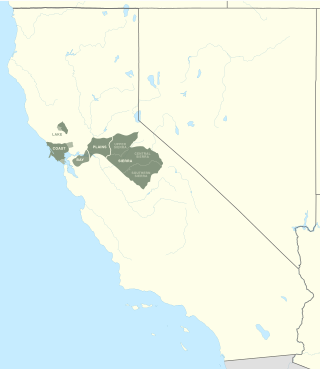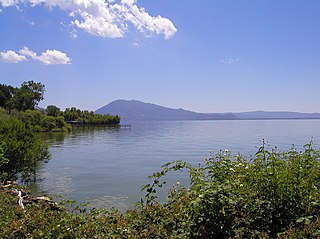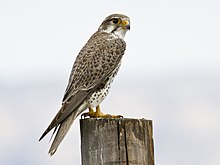
The Indigenous peoples of the Americas comprise numerous different cultures. Each has its own mythologies, many of which share certain themes across cultural boundaries. In North American mythologies, common themes include a close relation to nature and animals as well as belief in a Great Spirit that is conceived of in various ways.

The Pomo are a Native American people of California. Historical Pomo territory in Northern California was large, bordered by the Pacific Coast to the west, extending inland to Clear Lake, and mainly between Cleone and Duncans Point. One small group, the Tceefoka, lived in the vicinity of present-day Stonyford in Colusa County, separated from the core Pomo area by lands inhabited by Yuki and Wintuan speakers.

The Miwok are members of four linguistically related Native American groups indigenous to what is now Northern California, who traditionally spoke one of the Miwok languages in the Utian family. The word Miwok means people in the Miwok languages.

The Coast Miwok are an Indigenous people of California that were the second-largest tribe of the Miwok people. Coast Miwok inhabited the general area of modern Marin County and southern Sonoma County in Northern California, from the Golden Gate north to Duncans Point and eastward to Sonoma Creek. Coast Miwok included the Bodega Bay Miwok, or Olamentko (Olamentke), from authenticated Miwok villages around Bodega Bay, the Marin Miwok, or Hookooeko (Huukuiko), and Southern Sonoma Miwok, or Lekahtewutko (Lekatuit). While they did not have an overarching name for themselves, the Coast Miwok word for people, Micha-ko, was suggested by A. L. Kroeber as a possible endonym, keeping with a common practice among tribal groups and the ethnographers studying them in the early 20th Century and with the term Miwok itself, which is the Central Sierra Miwok word for people.
The Bay Miwok are a cultural and linguistic group of Miwok, a Native American people in Northern California who live in Contra Costa County. They joined the Franciscan mission system during the early nineteenth century, suffered a devastating population decline, and lost their language as they intermarried with other native California ethnic groups and learned the Spanish language.

Coyote is a mythological character common to many cultures of the Indigenous peoples of North America, based on the coyote animal. This character is usually male and is generally anthropomorphic, although he may have some coyote-like physical features such as fur, pointed ears, yellow eyes, a tail and blunt claws. The myths and legends which include Coyote vary widely from culture to culture.

The Lake Miwok are a branch of the Miwok, a Native American people of Northern California. The Lake Miwok lived in the Clear Lake basin of what is now called Lake County. While they did not have an overarching name for themselves, the Lake Miwok word for people, Hotsa-ho, was suggested by A. L. Kroeber as a possible endonym, keeping with a common practice among tribal groups and the ethnographers studying them in the early 20th Century and with the term Miwok itself, which is the Central Sierra Miwok word for people.
The indigenous religion of the Pomo people, Native Americans from Northwestern California, centered on belief in the powerful entities of the 'Kunula', a Coyote, and 'Guksu', a spirit healer from the south.

The Plains and Sierra Miwok were once the largest group of California Indian Miwok people, Indigenous to California. Their homeland included regions of the Sacramento Valley, San Joaquin Valley, and the Sierra Nevada.
The traditional narratives of Native California are the folklore and mythology of the native people of California. For many historic nations of California, there is only a fragmentary record of their traditions. Spanish missions in California from the 18th century Christianized many of these traditions, and the remaining groups were mostly assimilated to US culture by the early 20th century. While there are sparse records from the 18th century, most material was collected during the 19th and the early 20th centuries.
The mythology of the Ohlone (Costanoan) Native American people of Northern California include creation myths as well as other ancient narratives that contain elements of their spiritual and philosophical belief systems, and their conception of the world order. Their myths describe supernatural anthropomorphic beings with the names of regional birds and animals, notably the eagle, the Coyote who is humanity's ancestor and a trickster spirit, and a hummingbird.

Kuksu was a religion in Northern California practiced by members within several Indigenous peoples of California before and during contact with the arriving European settlers. The religious belief system was held by several tribes in Central California and Northern California, from the Sacramento Valley west to the Pacific Ocean.
Plains Miwok and Sierra Miwok traditional narratives include myths, legends, tales, and oral histories preserved by the Miwok people of the central California, specifically those of Sacramento Valley and Sierra Mountains. These Miwoks are the linguistically related speakers of the Plains and Sierra Miwok languages and their descendants. At the time of European entry, local groups that spoke these languages participated in the general cultural pattern of central California.
Lake Miwok traditional narratives include myths, legends, tales, and oral histories preserved by the Lake Miwok people of Clear Lake in the North Coast Range of northwestern California.
Maidu traditional narratives include myths, legends, tales, and oral histories preserved by the Maidu, Konkow, and Nisenan people of eastern Sacramento Valley and foothills in northeastern California.
Patwin traditional narratives include myths, legends, tales, and oral histories preserved by the Patwin peoples of the Wintun people of the southwestern Sacramento Valley in northern California.
Pomo traditional narratives include myths, legends, tales, and oral histories preserved by the Pomo people of the North Coast region of northwestern California.
Wintu-Nomlaki traditional narratives include myths, legends, tales, and oral histories preserved by the Wintu and Nomlaki people of the western Sacramento Valley in northern California.
Yokuts traditional narratives include myths, legends, tales, and oral histories preserved by the Yokuts people of the San Joaquin Valley and southern Sierra Nevada foothills of central California.
Tuluka is a former Patwin village in Napa County, California. It was located southeast of Napa, but its precise location is unknown.










